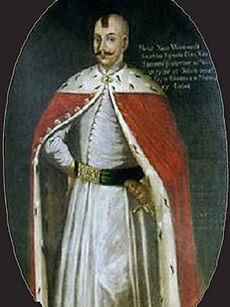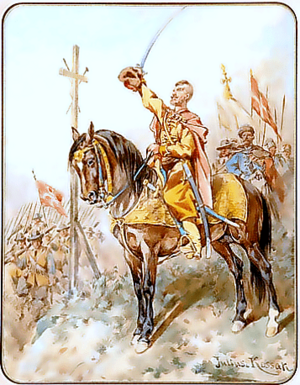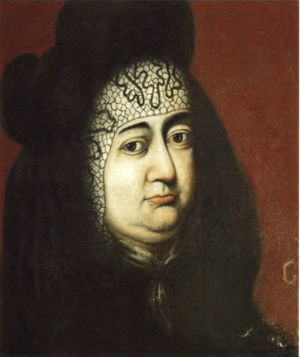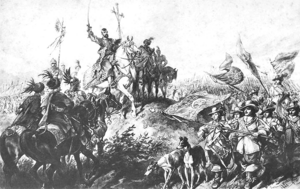Jeremi Wiśniowiecki facts for kids
Quick facts for kids
Jeremi Wiśniowiecki
|
|
|---|---|
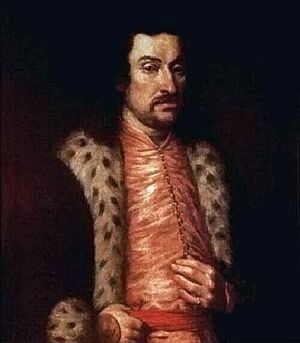
Portrait by Daniel Schultz
|
|
| Coat of arms | 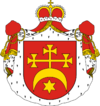 |
| Full name |
Jeremi Michał Korybut Wiśniowiecki
|
| Born | 1612 Lubny, Kyiv Voivodship, Polish–Lithuanian Commonwealth |
| Died | 20 August 1651 (aged 38–39) Pawołocz, Polish–Lithuanian Commonwealth |
| Noble family | Wiśniowiecki |
| Spouse(s) |
Gryzelda Konstancja Zamoyska
(m. 1639) |
| Issue | Michał Korybut Wiśniowiecki |
| Father | Michał Wiśniowiecki |
| Mother | Regina Mohyła (Raina Mohylanka) |
Prince Jeremi Michał Korybut Wiśniowiecki (born in 1612 – died August 20, 1651) was a very important noble and military leader in the Polish–Lithuanian Commonwealth. He was sometimes called the Hammer on the Cossacks because of his strong actions against them. Jeremi was a prince from the Wiśniowiecki family. He was also the father of Michael I, who later became the King of Poland.
Jeremi Wiśniowiecki was a powerful magnate (a very rich and influential noble) and a skilled military commander. His family had roots in Ruthenia (modern-day Ukraine) and Moldavia. He inherited a huge fortune and became one of the wealthiest people in the Commonwealth. He ruled over lands where about 230,000 people lived. In 1646, he became the voivode (a high-ranking official) of the Ruthenian Voivodship. Jeremi changed his religion from Eastern Orthodoxy to Roman Catholicism. This caused some disagreements in the Ukrainian lands, which were part of the Commonwealth.
Contents
His Early Life
Jeremi Michał Korybut Wiśniowiecki was born in 1612. We don't know the exact date or place of his birth. His father, Michał Wiśniowiecki, died in 1616, soon after Jeremi was born. His mother, Regina Mohyła, was from Moldavia and died in 1619. Both of his parents followed the Eastern Orthodox Church. Jeremi's uncle was Petro Mohyla, a very important Orthodox religious leader.
Jeremi became an orphan at age seven. He was raised by his uncle, Konstanty Wiśniowiecki, who was a Roman Catholic. Jeremi went to a Jesuit school in Lviv. Later, in 1629, he traveled to Italy and studied briefly at the University of Bologna. He also gained military experience in the Netherlands. His upbringing and travels helped him become more "Polish" in his ways. He grew into one of the youngest and most powerful magnates of Poland and Lithuania.
In 1631, Jeremi returned to the Commonwealth. He took over his father's huge estate from his uncle. This estate included a large part of what is now Ukraine. In 1632, he changed his religion from Eastern Orthodoxy to Catholicism. This decision worried many people in Ukraine. The Orthodox Church feared losing a strong protector. Even though he converted, Jeremi stayed on good terms with the Orthodox Church. He supported his uncle, Petro Mohyla, and his Orthodox school.
His Military Career
Jeremi Wiśniowiecki's first biographer, Michał Kałyszowski, said that Jeremi fought in nine wars. His first war was the Smolensk Campaign in 1633–34 against the Tsardom of Russia. He fought in several battles and helped capture some towns. For his service, King Władysław IV Vasa praised him. Jeremi also received the important position of castellan of Kyiv.
After the war, Wiśniowiecki had some conflicts with other powerful nobles. He had a large private army of several thousand soldiers. This army helped him settle disputes in his favor. He bought more lands and added them to his already huge estates.
Around 1636, the Sejm (the Polish parliament) did not want King Władysław IV Waza to marry Jeremi's sister, Anna. After this, Jeremi kept some distance from the royal court. However, he still returned to Warsaw as a representative from the Ruthenian Voivodeship. On February 27, 1639, Jeremi married Gryzelda Zamoyska. She was the daughter of Chancellor Tomasz Zamoyski.
Jeremi also got involved in a debate about noble titles. He successfully defended the old prince titles, including his family's. This made him an enemy of another powerful noble, Jerzy Ossoliński.
Fighting Cossack Uprisings
In 1637, Wiśniowiecki might have fought against the Cossack rebellion led by Pavlo Pavliuk. Historians are not sure about his exact role. A year later, he gathered a 4,000-strong army. This army helped put down the Ostrzanin Uprising. Together with Hetman Mikołaj Potocki, he defeated the rebels at the Battle of Żownin.
In 1641, Jeremi became the last adult male of the Wiśniowiecki family. He inherited all the remaining family estates. He also fought against the Tatars from 1640 to 1646. Their raids on the Commonwealth's border threatened his lands. In 1644, he helped Hetman Stanisław Koniecpolski win the Battle of Ochmatów against the Crimean Tatars.
In 1646, Jeremi became the voivode of Ruthenia. This gave him a seat in the Senate of Poland. He was the third Wiśniowiecki family member to achieve this honor. However, he refused to support King Władysław's plan for a war against the Ottoman Empire.
The Khmelnytsky Uprising
Wiśniowiecki fought against the Cossacks again during the Khmelnytsky Uprising from 1648 to 1651. He learned about the growing unrest and started getting his troops ready. In early May, he heard about the Cossack victory at the Battle of Zhovti Vody. Since he received no orders from the main commanders, he started moving his own army. His troops, about 6,000 strong, were the only Polish forces in the region at that time.
He began retreating, and his army became a safe place for many refugees. He fought some smaller battles against Cossack forces. By July, he arrived near Zbarazh. Jeremi's fighting retreat was very important in the war. He was not defeated, and this made it harder for politicians in Warsaw to negotiate peace with the Cossacks.
Around late August, Wiśniowiecki met with other army commanders. He was not very friendly with them because he felt he should have been given higher military positions. But he agreed to follow their orders. On September 23, their forces were defeated at the Battle of Pyliavtsi. Near the end of the battle, some say Jeremi was offered the top commander's job, but he refused. Later, he was given a temporary field commander role. He decided to retreat towards the strong fortress in Zamość instead of Lviv.
Meanwhile, a new king, Jan Kazimierz II Vasa, was chosen. Wiśniowiecki supported other candidates. He was not given a permanent top military position. However, after much debate, he was given a document saying he had "power equal to that of a hetman." Jeremi wanted a larger army, but others hoped for a peaceful solution. The army was not made much stronger.
In 1649, talks with the Cossacks failed. The Polish-Lithuanian army gathered near Ukraine. A large camp was in Zbarazh. Jeremi arrived there in late June with a new army of 3,000 soldiers. This was all he could afford because the Cossacks had taken over most of his lands. Jeremi's arrival made the royal army feel more hopeful. Even without an official rank, soldiers and commanders listened to his advice. During the siege of Zbarazh, Jeremi was the real, unofficial commander of the army. The siege ended with a ceasefire called the Treaty of Zboriv.
Jeremi's leadership during the siege was seen as amazing. His popularity grew among the troops and nobles. However, the King still didn't like him much and gave him a small reward. Later, the King needed Jeremi's support and gave him another temporary commander role. In April 1650, Jeremi had to give up this role. In December that year, Jeremi's military supporters convinced the Sejm to increase the army size to 51,000. This was the largest army since the Cossack uprising began.
The peace treaty did not last long. In the spring of 1651, Khmelnytsky's Cossacks started moving west again. On June 1, 1651, Wiśniowiecki brought his private army to face the Cossacks in Sokal. He commanded the left side of the Polish-Lithuanian army in the winning Battle of Berestechko from June 28–30.
On August 14, Jeremi Wiśniowiecki suddenly became ill in a camp near the village of Pawołocz. He died on August 20, 1651, at only 39 years old. The cause of his death is not known for sure. Some people at the time thought he was poisoned, but there is no proof. Some historians think he might have died from a disease like cholera. One story says he ate cucumbers and drank mead, which caused him to get dysentery. He was given a formal funeral with the whole army present.
Jeremi's family was in debt and could not afford a grand funeral for him. His body was placed temporarily in the monastery of the Holy Cross at Łysa Góra. This became his final resting place. His body was thought to be lost in a fire in the late 1700s. However, a body believed to be his has been found and is now on display in the monastery.
His Great Wealth
Most of the Wiśniowiecki family's lands were on the eastern side of the Dnieper River. Jeremi's grandfather, Aleksander Wiśniowiecki, gained most of these lands in the 1500s. The main center of Jeremi's estate was a strong manor in Lubny. His father had rebuilt an old castle there. In 1628, Jeremi inherited lands with about 4,500 people. Lubny was the largest town. Other towns included Khorol, Pyriatyn, and Pryluky.
By 1646, his lands were home to 230,000 people. The number of towns on his lands grew from a few to about thirty. The population also increased. This shows Jeremi's good skills in managing money and land. The income from his lands was about 600,000 zlotys each year. This made him one of the richest nobles in the Commonwealth. Because of its large size and clear borders, Jeremi's estate was often called Wiśniowieczczyzna ("Wiśniowieckiland").
Even with all his wealth, Jeremi was not known for living a very fancy life. His court of about a hundred people was not overly grand. He did not build luxurious homes. He didn't even have a portrait of himself made during his lifetime. We don't know exactly what Jeremi Wiśniowiecki looked like. Many historians focus on his military and political life. Few talk about how well he managed his estates.
See also
- Lithuanian nobility
- Wiśniowiecki family
- List of szlachta



